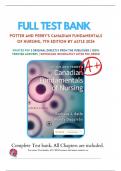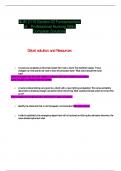,Table of Contents
Chapter 01 Health and Wellness 2
Chapter 02 The Canadian Health Care Delivery System 11
Chapter 03 The Development of Nursing in Canada 19
Chapter 04 Community Health Nursing Practice 25
Chapter 05 Theoretical Foundations of Nursing Practice 34
Chapter 06 Evidence-Informed Practice 40
Chapter 07 Nursing Values and Ethics 48
Chapter 08 Legal Implications in Nursing Practice 56
Chapter 09 Global Health 67
Chapter 10 Indigenous Health 75
Chapter 11 Nursing Leadership, Management, and Collaborative Practice 83
Chapter 12 Critical Thinking in Nursing Practice 91
Chapter 13 Nursing Assessment, Diagnosis, and Planning 99
Chapter 14 Implementing and Evaluating Nursing Care 110
Chapter 15 Documenting and Reporting 121
Chapter 16 Nursing Informatics and Canadian Nursing Practice 135
Chapter 17 Communication and Relational Practice 142
Chapter 18 Patient-Centred Care Interprofessional Collaborative Practice 154
Chapter 19 Family Nursing 161
Chapter 20 Patient Education 175
Chapter 21 Developmental Theories 187
Chapter 22 Conception Through Adolescence 196
Chapter 23 Young to Middle Adulthood 206
Chapter 24 Older Persons 215
Chapter 25 The Experience of Loss, Death, and Grief 226
Chapter 26 Self-Concept 236
Chapter 27 Sexuality 244
Chapter 28 Spirituality in Health and Health Care 253
Chapter 29 Stress and Adaptation 261
Chapter 30 Vital Signs 269
Chapter 31 Pain Assessment and Management 286
Chapter 32 Health Assessment and Physical Examination 302
Chapter 33 Infection Control 317
Chapter 34 Medication Administration 335
Chapter 35 Complementary and Alternative Approaches in Health Care 350
Chapter 36 Activity and Exercise 358
Chapter 37 Quality and Patient Safety 370
Chapter 38 Hygiene 382
Chapter 39 Cardiopulmonary Functioning and Oxygenation 401
Chapter 40 Fluid, Electrolyte, and Acid–Base Balances 417
Chapter 41 Sleep 433
Chapter 42 Nutrition 441
Chapter 43 Urinary Elimination 457
Chapter 44 Bowel Elimination 472
Chapter 45 Mobility and Immobility 485
Chapter 46 Skin Integrity and Wound Care 503
Chapter 47 Sensory Alterations 523
Chapter 48 Care of Surgical Patients 534
, Chapter 01: Health and Wellness
Potter et al: Canadian Fundamentals of Nursing, 7th Edition
MULTIPLE CHOICE
1. The nurse is using the population health promotion model to develop actions for
improving health. After asking, “On what should we take action?”; “How should we take
action?”; and “Why should we take action?” the nurse will ask which of the following
questions?
a. “With whom should we act?”
b. “When should we take action?”
c. “Which government should take action?”
d. “Where should we first act?”
ACTUAL
SOLUTION>>> A
The next question to ask when using the population health model approach is “With whom
should we act?” The other choices are not questions included in this model.
DIF>>> Apply REF PAGE>>> 13 (Figure 1-5)
OBJ>>> Contrast distinguishing features of health promotion and disease prevention.
TOP>>> Implementation MSC: NCLEX: Health Promotion and Maintenance
2. The principle “Health promotion is multi sectoral” means which of the following?
a. Relationships between individual, social, and environmental factors must be
recognized.
b. Physical, mental, social, ecological, cultural, and spiritual aspects of health must
be recognized.
c. In order to change unhealthy living and working conditions, areas other than health
must also be involved.
d. Health promotion uses knowledge from disciplines such as social, economic,
political, environmental, medical, and nursing sciences, as well as from first-hand
experience.
ACTUAL SOLUTION>>> C
The statement “Health promotion is multi sectoral” is the principle explained by the
necessity to involve areas other than health in order to change unhealthy living and
working conditions.
DIF>>> Understand REF PAGE>>> 11
OBJ>>> Contrast distinguishing features of health promotion and disease
prevention. TOP>>> Planning MSC: NCLEX: Health Promotion and
Maintenance
3. According to the World Health Organization, what is the best description of “health”?
a. Simply the absence of disease.
b. Involving the total person and environment.
c. Strictly personal in nature.
d. Status of pathological state.
ACTUAL SOLUTION>>> B
OBJECTIVE:
, DIF>>> Knowledge REF PAGE>>> 2
OBJ>>> Discuss ways that definitions of health have been
conceptualized. TOP>>> Evaluate MSC: NCLEX: Health
Promotion and Maintenance
4. What priority strategy for health promotion in Canada is optional but seen as important to
incorporate in nursing education curricula?
a. Knowledge of disease prevention.
b. Strategies for health promotion.
c. Policy advocacy.
d. Concepts of determinants of health.
ACTUAL SOLUTION>>> C
Increasingly, policy advocacy is incorporated into nursing role statements and nursing
education curricula. Nurses should think about policies that have contributed to health
problems, policies that would help alleviate health problems, and how nurses champion
public policies. Disease prevention, health promotion, and concepts of determinants of
health are integral parts of nursing curricula.
DIF>>> Understand REF PAGE>>> 11| 12
OBJ>>> Analyze how the nature and scope of nursing practice are influenced by
different conceptualizations of health and health determinants. TOP>>>
Planning MSC: NCLEX: Health Promotion and Maintenance
5. Which of the following is a prerequisite for health, as identified by the Ottawa Charter for
Health Promotion?
a. Education.
b. Social support.
c. Self-esteem.
d. Physical environment.
ACTUAL SOLUTION>>> A
Education is one of the nine prerequisites for health that were identified in the Ottawa
Charter for Health Promotion. Lack of social support and low self-esteem were identified
as psychosocial risk factors by Labonte (1993). Dangerous physical environments were
identified as socioenvironmental risk factors by Labonte (1993).
DIF>>> Understand REF PAGE>>> 4
OBJ>>> Discuss
contributions of the following Canadian publications to conceptualizations of health and health
determinants: Lalonde Report, Ottawa Charter, Epp Report, Strategies for Population Health,
Jakarta Declaration, Bangkok Charter, Toronto Charter. TOP>>>
Planning MSC: NCLEX: Health Promotion and Maintenance
OBJECTIVE:






